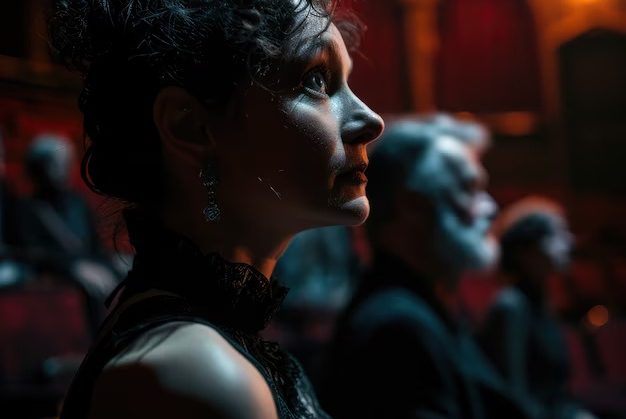
23 December 2024
The Fascinating Journey of History George Gershwin the Lullaby of Summertime

The fusion of grand vocal performances with visual storytelling has created moments in cinema that linger in the minds of audiences long after the credits roll. These unforgettable melodies transport listeners to new worlds, evoking a range of emotions and enhancing the overall narrative. As these brilliant compositions intertwine with compelling characters and dramatic plots, they elevate the cinematic experience to new heights.
Numerous films have drawn inspiration from extraordinary vocal expressions, showcasing their power and depth. These selections not only highlight the versatility of lyrical forms but also demonstrate their ability to resonate across various cultural landscapes. Discovering these remarkable pieces can transform one’s appreciation for both music and film, merging two art forms into a profound journey.
As we explore a curated collection of remarkable compositions, prepare to dive into the captivating realm where powerful voices meet the magic of cinema. Each track represents a unique blend of artistry that continues to inspire a love for storytelling through sound. Join us in celebrating these unforgettable performances that deserve a place in every connoisseur’s auditory repertoire.
Throughout cinematic history, the integration of timeless vocal works has brought a unique depth and emotional resonance to storytelling. These magnificent pieces possess the power to enhance scenes, evoking a range of feelings that elevate the overall experience for viewers. The rich tones and soaring harmonies create a connection between the audience and the narrative that is both profound and memorable.
The use of traditional vocal works in films serves not only as a backdrop but also as a narrative device that deepens character development and plot progression. Directors often choose these memorable compositions to underscore pivotal moments, allowing the music to amplify the emotional stakes. The dramatic nature of such works meshes seamlessly with visual storytelling, leaving a lasting imprint on the audience’s psyche.
<p by Integrating classic vocal pieces into contemporary cinema creates a bridge between different eras and cultures, inviting a diverse range of audiences to appreciate the beauty of these enduring masterpieces. This fusion of high art and popular culture encourages an appreciation for both the historical significance of the compositions and their relevance in today’s cinematic landscape. As a result, filmgoers are presented with an opportunity to engage with these exquisite melodies in a fresh and accessible context.
The world of vocal masterpieces possesses an unparalleled ability to evoke profound feelings, transcending time and culture. These exquisite melodies resonate deeply within the human soul, embodying themes of love, loss, joy, and despair. The emotional weight carried by each note creates a powerful connection between the performer and the audience, making it hard to forget.
One such powerful piece encapsulates the essence of longing and heartbreak. The soaring melodies spiral into realms of deep emotion, inviting listeners to experience an intimate journey through the trials of the human experience. The poignant lyrics, combined with the passionate delivery, resonate long after the last note fades.
Another remarkable composition masterfully conveys triumph and elation, filling the air with an infectious energy that uplifts the spirit. Its intricate harmonies and dynamic contrasts engage listeners, transporting them to moments of victory and celebration. The skillful use of vocal techniques enhances the overall impact, leaving an indelible mark on the heart.
These remarkable creations not only showcase the artistry and skill of the performers but also serve as timeless reminders of the complexities of human emotion. Their lasting legacy continues to inspire generations, proving that the beauty of these masterpieces transcends their origins and remains a vital part of our cultural tapestry.
The powerful melodies and dramatic narratives found within classical vocal music have left an indelible mark on the world of cinema. These art forms intertwine, enriching the viewing experience and evoking a spectrum of emotions that transcend spoken language. By incorporating these sophisticated vocal pieces, filmmakers enhance their storytelling, adding layers of depth and resonance.
<pThroughout history, various directors and composers have recognized the emotional weight carried by these timeless works. Their ability to convey passion, tragedy, and triumph allows them to resonate with audiences on a profound level. The choice of incorporating such pieces often reflects the characters’ inner turmoil or the film’s overarching themes, creating an unforgettable auditory backdrop.
<pAdditionally, the dramatic elements inherent in this genre perfectly complement the visual spectacle of film, heightening tension or underscoring moments of beauty and poignancy. This unique synergy has led to memorable scenes that linger in the minds of viewers long after the credits roll. As a result, the influence of these grand musical traditions continues to shape modern soundtracks and captivate audiences around the world.
Throughout the history of cinema, certain dramatic moments have been elevated through the inclusion of classical vocal masterpieces. These timeless compositions have the power to evoke deep emotions, enhance storytelling, and create lasting memories in the minds of audiences. Their grandeur often adds an extra layer of depth to pivotal scenes, leaving viewers enchanted and moved.
One particularly memorable instance occurs in a film where a powerful aria underscores a climactic confrontation, amplifying the tension and intensity of the moment. The soaring melodies perfectly align with the characters’ struggles, transforming a mere scene into a profound emotional experience.
Another remarkable sequence showcases a delicate duet that plays during a tender reunion, its harmonies weaving seamlessly into the narrative. This exquisite selection not only highlights the scenery but also encapsulates the essence of love, making the moment even more poignant.
Additionally, the stirring resonance of a dramatic finale can be witnessed in a pivotal plot twist, as the music crescendos alongside the unfolding events. This synergy creates an unforgettable atmosphere, ensuring that the audience is both mesmerized and engaged.
Overall, the integration of these classical vocal masterpieces into cinematic storytelling has resulted in extraordinary moments that resonate long after the credits roll. Their ability to intertwine with visual narratives enhances the overall experience, leaving a lasting impression on viewers around the globe.
The intersection of classical music and cinema has long provided a rich tapestry of auditory experiences. Many distinguished composers have lent their masterpieces to enhance the storytelling of films. These contributions not only elevate the emotional impact of scenes but also introduce audiences to the depths of classical artistry.
Here are some prominent composers whose works have transcended the concert hall and found a place in the film industry:
The influence of these maestros extends beyond mere background scores. They shape characters, drive plot development, and leave a lasting impression on audiences. The synergy between their timeless works and cinematography fosters a deeper connection to the story being told.
The magic of the human voice transcends mere communication, resonating deeply with our emotions and experiences. Its ability to convey complex feelings and narratives makes it an essential element in various forms of art, including the dramatic world of theatrical music. Through the skillful manipulation of tone, volume, and phrasing, vocalists can transport listeners to different realms, stirring passions and evoking memories that might otherwise remain dormant.
The craftsmanship involved in a vocal presentation showcases the unique qualities of an artist’s instrument. Each singer brings their own interpretation, influencing how a piece is perceived. The nuances of breath control, emotional expression, and vocal agility create a tapestry of sound that captivates audiences worldwide. Whether in a grand auditorium or an intimate setting, the sheer power of the voice has the capacity to unify people, drawing them into a shared experience that resonates long after the final note is sung.
Dramatic performances elevate storytelling to new heights, often imprinting resonant themes onto the cultural landscape. This powerful form of expression not only entertains but also challenges social norms and reflects the complexities of the human condition. From profound love stories to tales of struggle and triumph, the richness of vocal performance lends itself to a myriad of interpretations, each leaving an indelible mark on the hearts of those who listen.
“Nessun dorma” is a famous aria sung by the character Calaf in Puccini’s opera “Turandot.” It is significant because it expresses Calaf’s determination to win the love of the cold Princess Turandot, culminating in the powerful line, “Vincerò!” which means “I will win!”
Luciano Pavarotti’s powerful tenor voice and emotive interpretation of “Nessun dorma” brought the aria to international fame. His performance during the Three Tenors concert in 1990 made it a signature piece for him, showcasing his vocal prowess and charisma.
The character Figaro is featured in Mozart’s opera “The Marriage of Figaro,” which is based on a play by Pierre Beaumarchais. The opera is celebrated for its intricate plot and memorable music, including the famous overture.
“Mio babbino caro” is an aria sung by the soprano character Lauretta in Puccini’s “Gianni Schicchi.” The theme revolves around her deep love for her father and her desire to marry her beloved, expressing both tenderness and longing.
In “Rigoletto,” Verdi delves into themes of fate and revenge through the tragic story of Rigoletto, a jester whose curse leads to devastating consequences. The emotional depth of the characters, particularly Rigoletto and his daughter Gilda, highlights the operatic exploration of these themes.
Violetta, the protagonist of Verdi’s “La Traviata,” represents the struggle between love and societal expectations. Her journey from a life of pleasure to tragic sacrifice resonates with audiences, making her one of opera’s most compelling heroines.
“Largo al factotum” is an aria from Rossini’s “The Barber of Seville,” sung by the character Figaro. It signifies Figaro’s role as a resourceful and charismatic barber who can solve problems for his clients, showcasing his lively personality and wit.
The Queen of the Night is a pivotal character in Mozart’s “The Magic Flute,” representing darkness and vengeance. Her famous aria, “Der Hölle Rache,” showcases her dramatic power and vocal demands, making her one of opera’s most iconic soprano roles.
The Habanera in Bizet’s “Carmen,” specifically the aria “L’amour est un oiseau rebelle,” introduces Carmen’s character and her views on love and freedom. This piece sets the tone for the opera’s exploration of passion and fate, establishing Carmen as a strong and independent figure.
“Nessun dorma” is popular among tenors due to its emotional intensity and vocal challenges. The aria requires a powerful voice capable of soaring high notes, making it a showcase piece that highlights a tenor’s range and expressive abilities, especially when performed by renowned artists like Luciano Pavarotti.
La donna è mobile is one of opera’s greatest arias, composed by Verdi, and is celebrated for its captivating melody and emotional expression.
Handel’s contributions to opera arias are significant, as his works often feature intricate vocal lines and lush orchestration that showcase the talents of both sopranos and mezzo-sopranos.
Mozart’s operas are filled with memorable moments, including the famous duet for soprano and tenor that captivates audiences with its charm and wit.
Verdi’s ‘Der Hölle Rache,’ known as the Queen of the Night aria from The Magic Flute, is one of opera’s most challenging and iconic pieces for sopranos.
Francis Ford Coppola’s films often reflect operatic storytelling, where every last man in Shawshank felt free, echoing themes of hope and redemption similar to those found in many operas.
Leave a comment